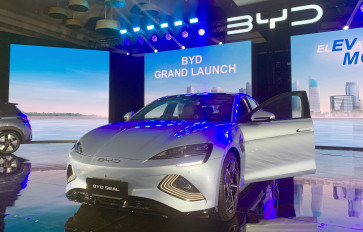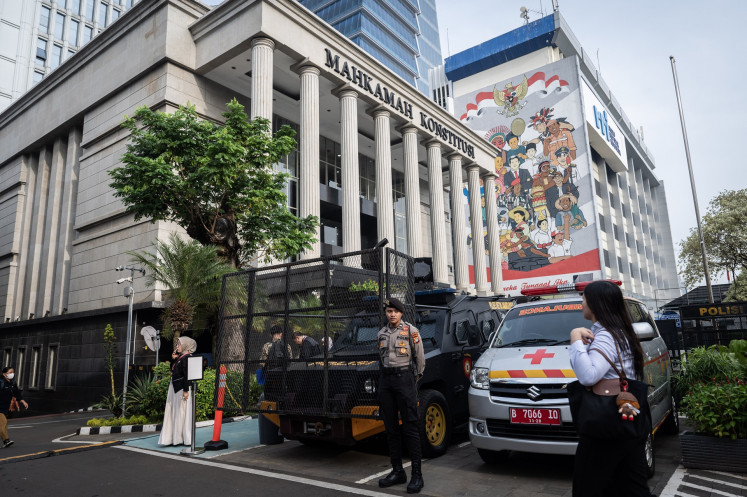Gamelan Bike Bike from bicycles to gamelan
Cross-cultural innovation: Appealing melodies and rhythms are produced under the masterful hands of talented musicians
Change text size
Gift Premium Articles
to Anyone

C
ross-cultural innovation: Appealing melodies and rhythms are produced under the masterful hands of talented musicians. (Courtesy of Yohei Shimomae)
A group of Vancouver musicians have fashioned gamelan from old bicycles, and are now working with Indonesian musicians to raise the profile of gamelan music.
In 1962, a young Frank Zappa appearing on Steve Allen’s late-night talk show demonstrated to his bemused host how to play music by hammering on the tubes and scraping the spokes of an old bicycle.
The resulting “music” was a horrendous cacophony counterpointed by Zappa’s straight-faced Dadaist commentary — an excellent piece of performance art.
A half-century later, the bicycle is once again taking center stage in a performance — only this time producing appealing melodies and sophisticated rhythms under the masterful hands of talented musicians.
In this version of Zappa’s “musical” bicycle, steel tubes were scavenged from old bicycle frames, cut to length, and mounted on a wooden frame to fashion a gender, a metallophone that is the primary instrument of an Indonesian gamelan orchestra.
With the addition of a large bronze gong and a few other components, the bicycle parts have become Gamelan Bike Bike (GBB) — a collective of Canadian and Indonesian musicians based in Vancouver, Canada.
The collective was founded by George Rahi, a musician working, as many young artists do, at a day job, in this case a bicycle repair shop.
He was looking to explore his interest in experimental music, but his limited budget compelled him to be exceptionally creative not only in the music, but in fashioning the instruments themselves.

He played around with using tubes cut from bicycle frames to make a sort of xylophone, but a chance encounter with the gamelan group at the University of British Columbia provided Rahi with an inspiration.
When properly cut to length and suspended in a harness, and hammered with a wooden mallet, steel bicycle-frame tubes produce a sound analogous to the bronze keys of the gender.
This sound is thinner and with a higher pitch, but still recognizable as gamelan music.
The best tubes were salvaged from the 1960s-era road bikes, in which the thick walls and heavy steel alloys produced a solid resonance like a traditional bronze gamelan.
As the “keys” of the GBB gender were fashioned from materials from many sources, the orchestra has a peculiar and distinct sound.
Despite the unorthodox materials used to construct GBB’s instruments, the orchestra is recognized as an authentic gamelan orchestra. In Indonesia, gamelan have been made of many metals, including aluminum and iron. The sole criteria is that the instrument must be able to be tuned to one of the two recognized seven-tone scales.
“There is a lot of freedom in how to tune gamelan,” Rahi said. “So we exploited that flexibility.”
Nevertheless, the collective is a novelty in the world of gamelan, a perception the group exploits to full advantage to raise awareness of the Indonesian art form.

In addition to attracting audiences of gamelan aficionados (and, one might assume, bicyclists), GBB teams up with other progressive artists, such as electronic musicians, and participates in music festivals to introduce gamelan to a wider community of progressive, folk and even popular music fans.
GBB has also attracted the attention of mainstream gamelan players both in Indonesia and in Vancouver.
In Indonesia, especially, gamelan is so ubiquitous that creative players find it hard to rise above the crowd and distinguish themselves by writing new music.
Many direct their efforts toward writing material for other genres, such as prog and metal. GBB has given these musicians the opportunity to explore their creativity in this uniquely Indonesian musical art form.
This creative input from Indonesia itself is driving the collective forward into further explorations of gamelan music.
Like a junkyard band with high expectations, Rahi and his ensemble strive to bring gamelan music to both greater creative heights and wider audiences.
GBB, an unlikely blend of Asian musical tradition and Western transportation technology, has proved to be a fertile environment for cross-cultural artistic innovation, presenting Indonesian music from a uniquely Vancouver perspective.
It is fitting that gamelan is powering this exploration of musical boundaries. As Rahi notes, “In many respects, gamelan, especially the dynamic Balinese style played by Gamelan Bike Bike, was the original metal music.” (ste)









